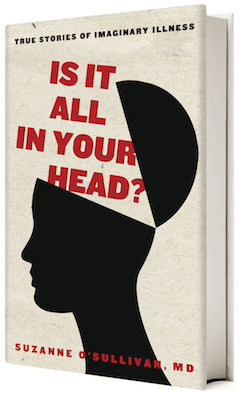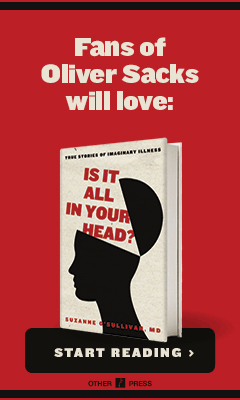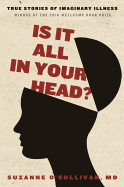Is It All in Your Head? True Stories of Imaginary Illness
by Suzanne O'Sullivan, M.D.
"When words are not available our bodies sometimes speak for us--and we have to listen," says Dr. Suzanne O'Sullivan in Is It All in Your Head? This fascinating casebook with historical insights--compiled by a seasoned neurologist who is now a consultant at the National Hospital of Neurology and Neurosurgery in London--offers a thorough examination of the significant yet complicated role emotions play in physical illness and the stigmas attached to psychosomatic disorders.
In 1995, O'Sullivan started her first training post as a neurologist. She ultimately found that she was drawn to the evaluation and care of those whose illnesses originated not in the body, but in the mind. O'Sullivan believes the body constructs a multitude of ways to express emotion. Sometimes those manifestations are benign, such as blushing when embarrassed or feeling dizzy when overwhelmed. There are other instances, however, where the body's reaction to stressors can be much more pronounced and dramatic, causing the body to seriously malfunction. This can lead a person to suffer illnesses such as chronic fatigue and more complex and incapacitating neurological disorders such as seizures, paralysis and even blindness.
Through a series of case studies, O'Sullivan details the many ways in which physical symptoms can mask emotional distress, as "neurological disease manifests in elusive and strange ways." This book documents the "brave people" she has encountered who display medically unexplained neurological symptoms. When patients learn that their physical distress is based on a psychological cause, O'Sullivan bears the brunt of their frustrations. After more than 20 years as a physician, she has seen how the "system" has often failed these patients and the ways in which a diagnosis of psychosomatic disorder affects how they perceive themselves and how others perceive them. Sometimes, patients find themselves trapped between the worlds of physiological medicine and psychiatry. And in many instances, neither community takes responsibility. The stigmas attached to patients who endure psychosomatic disorders--accounting for about one-third of every general neurology practice--and how little has been done to improve their care and management were largely instrumental in spurring O'Sullivan to write this book.
Many of O'Sullivan's patients suffer not only from disability, but also undergo invasive medical testing and procedures that produce a lack of evidence to support their symptoms--"a disease is sought but not found." A psychosomatic diagnosis is a hard pill for some patients to swallow--many become angry, sad and defensive, claiming it's like being told they're crazy, or faking or lying about their illnesses. Such a diagnosis can seem like an insult rather than an explanation. There are scenes with a very bright, wheelchair-bound, paralyzed patient, who is fond of doing extensive research about his condition on the Internet, and another consult with a happily married wife and mother who is experiencing an onslaught of seizures. In both of these instances, when the patients were given the good news that no neurological disease was found--no brain tumor for the paralyzed patient and seizures non-epileptic in nature--they reacted as though it would have been easier to be diagnosed with a physiological disease than to have to deal with the implications of a psychosomatic conclusion.
O'Sullivan demonstrates how she must often act as a psychological detective because the subconscious and psychiatric dissociation are often culprits for physical infirmity: "How an illness evolves is of great importance if you are ever to find a cause." This is evidenced in the intriguing case of a middle-aged woman who loses her vision after a cleaning solution comes in contact with her eyes. A lengthy battery of tests and clinical exams prove inconclusive to offering a cause of her blindness. It is later discovered that the patient had been avoiding dealing with significant stressors in her marriage. "Often the physical symptom is there in place of the emotional upset," explains O'Sullivan.
O'Sullivan believes that having a compassionate discussion often leads a patient on the road to a cure. She asserts that with intense psychiatric follow-up and intervention, negative feelings can be discharged and thus some patients--unfortunately, not all--can and do recover. In many instances, she has to buck peer protocols in order to adhere to her diagnoses.
O'Sullivan seamlessly weaves in historical facts, quotes, examples and theories about psychosomatic illness and its study by notables throughout the ages: Hippocrates, Pierre Janet, Jean-Martin Charcot, Josef Breuer and Freud among others. The details of each case are offered in layman's terms and are further supplemented with richly drawn scenes of doctor-patient dialogue. These enhancements deepen O'Sullivan's probing of the often unfathomable mystery of the intimate mind-body connection. This, along with neurological approaches to identifying triggers of psychosomatic illness and subsequent treatment, offers plentiful information for those in medical fields and patients--and for those who love and care for and about them.
While the stories in Is It All in Your Head? are intellectually and factually diverse, some are challenging to read--aspects of patient suffering become quite harrowing at times. Additionally, the delivery and impact of a psychosomatic diagnosis and subsequent patient response further tug emotionally at readers. O'Sullivan never trivializes the patient or what he or she is experiencing. Rather, she respects the strength of her patients and encourages them to find ways to address underlying psychological problems in order to overcome some incredible--some might even call them mind boggling--challenges in life. --Kathleen Gerard








